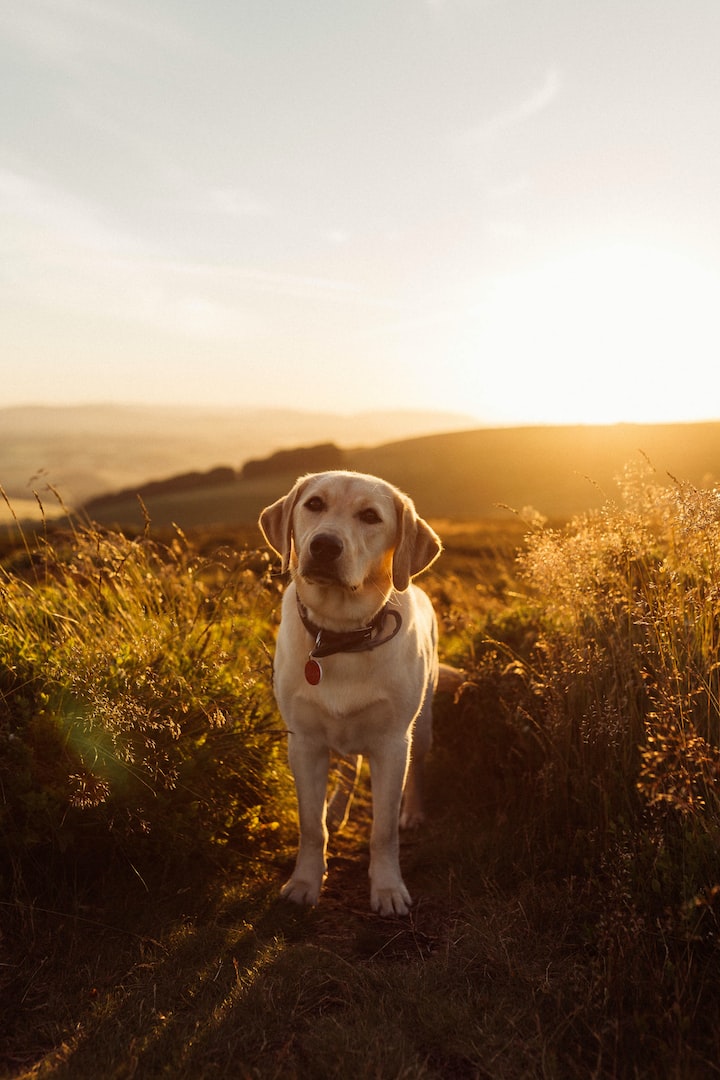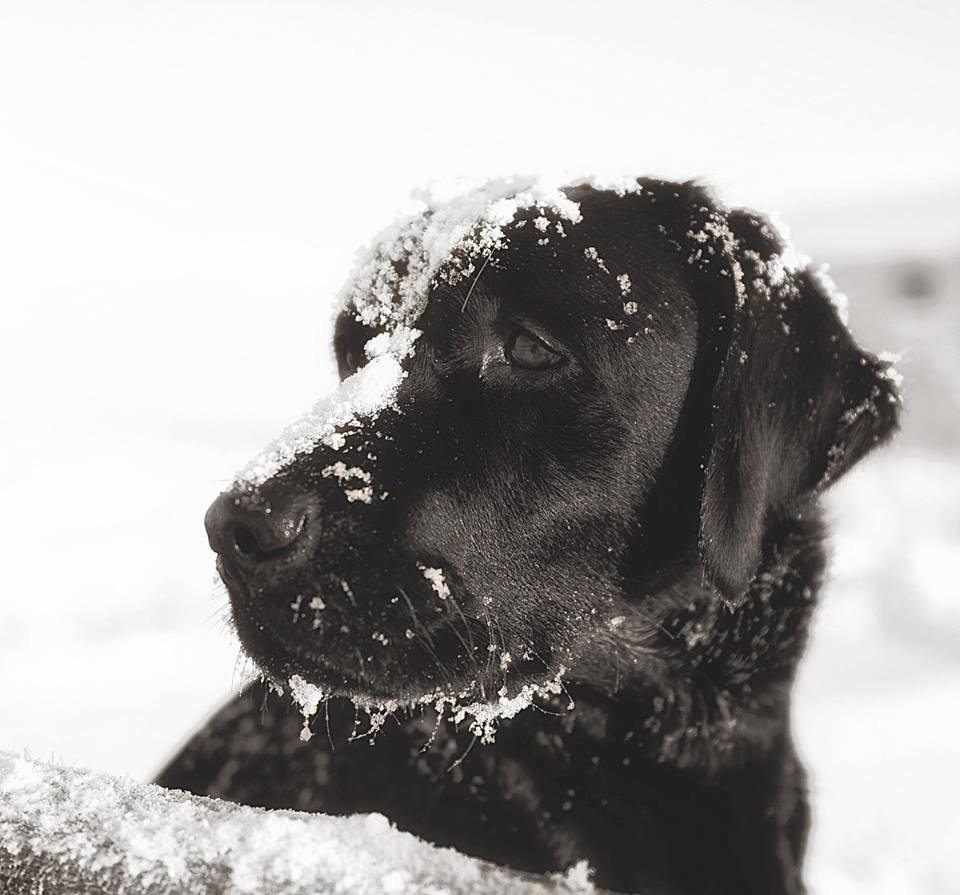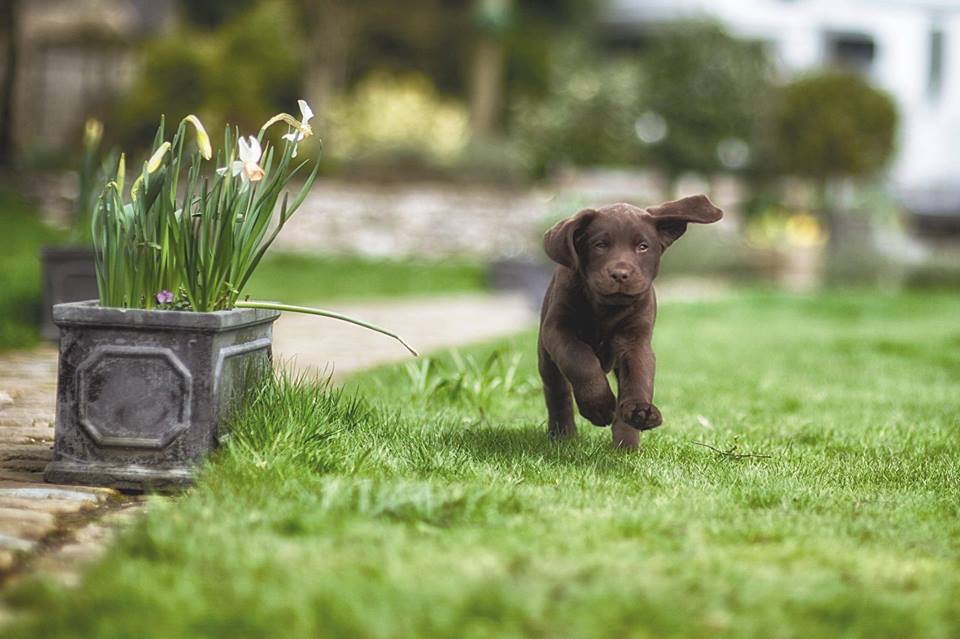
The Labrador Retriever
Has long been regarded as the most suitable pet throughout the world. Specially suited for hunting and often trained to hunt with gun sportsmen, the Lab has rightfully earned the title of a "gun dog." It is a remarkable working companion that is used for various purposes, such as physical assistance and personal protection. However, its loyalty and friendly temperament also make the Lab an outstanding pet.

Physical Characteristics
With a strong, heavy built body and square proportions, the Labrador Retriever is classified as a working dog. One of their trademark characteristic features is a strong jaw set in a broad head. These dogs also have strong legs and shoulders, which add to their fast pace. At full adult size, they stand at about 21 to 24 inches in height at the withers (the highest part of the back), with a weight of 50 to 80 pounds. The coat is straight, dense, and short, with the outer coat being a bit coarse, and the undercoat thick and soft. This makes the Labrador all but completely waterproof, with the thick undercoat protecting the skin, and the outer guard coat whisking water away. Labrador Retrievers have a certain distinct elegance, carrying themselves with an upright, proud demeanor, but with a friendly facial expression that invites new acquaintances and endears them to their human families.
The Labrador Retriever is generally categorized by lines that are destined for slightly different purposes. The show Labradors are bred for beauty and carriage -- for perfection in appearance, in other words. The hunting dogs follows the more traditional bloodlines, with usefulness being the key to perfection. The hunting Retriever has the physical characteristics that make it impervious to frigid water, an extraordinary sense of smell, and the agility to bag game with speed, along with companionable devotion to its human counterpart. Champion, or field trial Labradors, are bred for speed, energy, and intelligence, with appearance being the last consideration. Their appearance strays somewhat from the traditional Labrador -- they are quite trimmer, with smaller heads, and it is generally agreed that this line may be a bit too enthusiastic for the average dog owner. They require a much higher degree of exercise, and considerably more space to move around. Not least is the most popular category, the family Labrador.
Needless to say, this line is bred for intelligence, gentleness of temperament, tolerance, and a balance of energy with composure. They are as happy with a romp through the park as they are with a quiet evening at the hearth. No matter what differences in lines, all Labrador Retrievers are expected to maintain the characteristics that originally made them working dogs: stamina, energy, strength, and the ability to retrieve dependably, along with balanced structure and vitality.
The Labrador Retriever is found in black, chocolate, and yellow, with black being the most popular, and chocolate running a close second. The color of the nose should be the same as the color of the hair, with minimal fading. All other colors are the result of cross breeding and are not accepted as purebred Labrador Retrievers. The eyes should give the impression of intelligence and kindness; colors accepted for the eyes are brown for black and yellow haired Labs, and brown or hazel, for chocolate haired Labs.
Personality and Temperament
The Labrador Retriever has a strong hunting instinct and loves to roam. They are active, but calm and obedient if trained properly. Swimming and retrieving are the favorite activities of this breed, and they make good hunters on the field, and wonderful swimming companions. Regular exercise is a must to keep them fit. Labrador Retrievers are keen on learning, easy to get along with, affable types that get along well with other animals, children, and just about anyone they meet. The Labrador Retriever temperament makes them a top choice for families and excellent therapy dogs, but not an especially good choice for guard dog duty.
Care

A weekly combing is all that is needed for a Labrador Retriever, since their water resistant coat is also designed to be soil and rubbish resistant. While brushing is a luxury rather than a necessity since its coat is designed to naturally care for itself, it does go along way to improving your Lab's natural beauty and overall health. Regular exercise, on the other hand, is of the utmost importance. The Labrador is a high-energy dog that loves to play, and it should be given the opportunity to do this on a daily basis. When possible, Labrador Retrievers should be allowed to swim, as it is one of their favorite activities. Pools, beaches, rivers, lakes; all are sporting fun for a Lab. Just as with a child, you will want to safeguard your young Lab while it is in the water, to make sure it feels safe and has a way of getting out of the water. Over time, and with confidence, it will learn, but young swimmers can panic or tire quickly.
One thing that is especially important to keep in mind is that this breed has a tendency to retain weight if it is sedentary too often, or if it is given too many treats. One of the most common health problems for the modern Labrador is obesity. A healthy Labrador should have a trim, hourglass shape. While it may be tempting to treat your Lab pal often, in return for their unconditional affection, it is far better to treat your friend with quality playtime rather than edible treats. This will ensure that you and your Lab will enjoy a long and healthy companionship. Labradors do very well outside with a doghouse, as they are adaptable for outdoor conditions, but they prefer to live indoors, close to people, most of the time.
Health
Labrador Retrievers have a lifespan of 10 to 12 years. Some of the general health conditions that afflict Labradors are patellar luxation, canine hip dysplasia (CHD), and osteochondritis dissecans (OCD), which is canine elbow and shoulder dysplasia. This breed also occasionally suffers from distichiasis, exercise-induced collapse, diabetes, muscular dystrophy, tricuspid valve dysplasia, and entropion. Minor health concerns include retinal dysplasia, central progressive retinal atrophy (CPRA), hypothyroidism, hot spots, and cataract. Knee, hip, eye, and elbow tests should be included in the usual medical check-ups.
History and Background

The modern Labrador Retriever is the ancestral result of a popular fishing and retrieving dog from Newfoundland and Labrador, an Atlantic coastal province in Canada near the Labrador Sea; as such, the Labrador carries with it some relationship to the modern Newfoundland water dog. Originally, there were two distinct types under the one classification of Newfoundland dogs: the greater and the lesser, in which size was the main dictate for differentiating the two.
The lesser Newfoundland was black in color, smooth coated, and of a medium size, where the greater Newfoundland was considerably larger, and better suited for pulling heavy loads. Not to say that the lesser "Newfie" was incapable of pulling its fair share. Its great agility at fetching fishing lines and nets in the water and delivering them, along with its noteworthy style of affection and playfulness with families at the end of a long work day, made the smaller of the Newfoundland dogs the more popular choice for fishermen working in the waters off the coast of Newfoundland.
They also found that the lesser Newfie was useful for serving as the occasional tow barge. The strength and endurance of this breed was never lost to size. Also of great benefit to fishermen were the natural physical traits the lesser and greater Newfoundlands shared. Both are equipped with webbed toes and a two-layered coat, with a top-coat that repels water, and a tail that is broad at the base, serving as a sort of rudder while swimming.
Although the Newfoundland dogs suffered a loss of popularity for a time owing to a taxation on dogs in Canada, they had been frequent companions to Britain bound travelers during the 18th and 19th centuries and had, over that time, become a firmly entrenched member of the estate classes. It was the lesser of the Newfoundland breed that rose most in popularity, and in 1903, this trimmer and more energetic Newfoundland had made its way into the English Kennel Club, gaining a name all its own along the way: the Labrador Retriever. There, the breed was refined, particularly for retrieving game for hunters, becoming well regarded for its care in not damaging the game, for its devotion to human, and for its good manners.
It was accepted into the American Kennel Club in 1917, and has since grown in popularity over the years, becoming the indisputable leader in canine domestic companions.